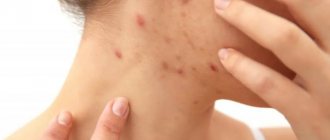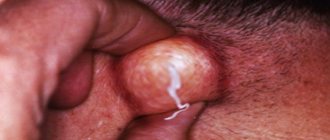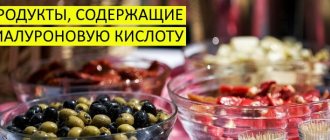January 27, 2021
Acne is an inflammatory disease of the skin, which is caused by changes in the sebaceous glands, as well as their excretory ducts and hair follicles. The causes of acne include heredity, hormonal imbalances, stress, gynecological diseases, taking certain medications, poor environment and unbalanced diet. To normalize sebum production, a diet is prescribed as a comprehensive component of treatment.
Meat products
I will immediately outline one fundamental point regarding meat: it is very important what exactly we use it with. Fatty meat eaten separately from carbohydrates will not cause much harm to our skin. But if we add potatoes or pasta to it, this can affect the composition of sebum and provoke inflammatory elements.
It is better to combine meat with fresh, stewed, boiled or steamed vegetables.
Also try not to overuse red meat: it is dangerous for diseases of the gastrointestinal tract and especially the intestines. Therefore, people who have relatives with bowel cancer should completely exclude this product from their diet. And vice versa, enrich your diet with chicken and fish.
Crunch on an apple, not chips. Putting together a balanced diet remotely Read more
How can poor diet cause acne?
Normally, sebum is secreted by the skin to maintain its protective functions, as it is an important component of the hydrolipid mantle and protects the epidermis from dehydration and negative environmental fusion. With increased work of the sebaceous glands, problematic skin secretes excess sebum, which clogs pores and creates a favorable environment for the development of bacteria and the appearance of blackheads.
In order for the skin condition to improve and acne relapses to decrease, it is important to regulate sebum production, normalize the function of the sebaceous glands and nourish the skin with missing vitamins and elements - a diet for the treatment of acne will do this perfectly.
By solving the problem from the inside, the diet will help the entire body as a whole, and a pleasant bonus to clear skin will be a noticeable improvement in overall well-being. Remember that every body is individual and, if possible, together with a nutritionist, create a personal nutrition plan aimed at combating rashes.
Dairy
Dairy products contain sugar in the form of lactose. Whole milk leads to the appearance of inflammatory elements in people prone to acne, and when drinking heavily, it promotes additional glycation of proteins in the skin.
Fermented milk products are considered healthier, but in some patients they can cause an inflammatory reaction.
Milk substitutes made from soy, buckwheat and oatmeal also contain a large amount of fast carbohydrates, so these products should be equated to sweet drinks and consumed as rarely as possible.
Unsweetened sweet death. What unobvious foods contains sugar? More details
Advice from a nutritionist for lactose and milk intolerance
“Why do I have such a reaction to milk?” — it is with this question that patients very often come to visit a gastroenterologist. Let's find out!
Milk is an emulsion, and therefore, due to its physical properties, it is a very favorable product for the digestive tract. It has viscosity and enveloping properties, which often has a good effect on the digestive system and the body as a whole.
Milk is a multicomponent product: proteins, fats, carbohydrates. There are as many sides to a product as there are so many possible problems. Complaints about fat content are usually rare, but the carbohydrate composition most often causes complaints, mainly due to the main sugar of milk - lactose!
Lactose intolerance (lactase deficiency) in adults is a fairly common phenomenon and depends both on hereditary predisposition and on the place of residence and tradition of drinking milk. For example, in the northern regions of Europe, lactose intolerance in adults occurs in 25% of the population, and among the indigenous peoples of Africa, Southeast Asia, North and South America, living closer to the equator, its frequency reaches 95%.
Lactase deficiency in adults is divided into secondary and primary. Primary lactase deficiency can manifest itself in childhood and can develop with age. Secondary occurs under the influence of intestinal infections and other causes that cause damage to cells of the small intestine of various origins.
According to the degree of severity, it is divided into hypolactasia - partial enzyme deficiency, and alactasia - complete enzyme deficiency.
What is the difference between lactose and lactase?
Lactose (milk sugar) is a carbohydrate of organic origin, which consists of two molecules of glucose and galactose and is one of the main components of mammalian and human milk. In its undigested form, lactose cannot be absorbed by intestinal cells. Therefore, to assimilate it, a reaction is carried out in the small intestine that separates lactose into its components - glucose and galactose, which, penetrating the cells of the small intestine, enter the general bloodstream and then the liver. In the liver, they are used to synthesize and store glycogen, which is fuel for the processes occurring in our body.
Beneficial properties of lactose
- plays the role of a prebiotic, improving the composition of microflora;
- participates in the synthesis of B vitamins;
- affects the absorption of calcium, magnesium and other microelements and its own enzymatic activity;
- is a source of energy.
Lactase is a special enzyme that is produced by the cells of the small intestine and controls the reaction of lactose breakdown. When the production of this enzyme decreases or stops, undigested lactose enters the large intestine, where a fermentation reaction occurs with the participation of bacteria, which produces an abundance of gases. In addition, if the consumption of dairy products regularly causes loose stools or pain, cramps, then an inflammatory reaction is triggered, which in the future can lead to prolonged duodenitis or functional disorders of the gastrointestinal tract, changes in the intestinal microflora.
Symptoms of lactose intolerance
The main clinical symptoms are loose stools (diarrhea), bloating, as well as disturbances in the gastrointestinal tract that occur immediately or within 24 hours after drinking milk or dairy products.
In addition, in the presence of intestinal dysbiosis, substances formed during the microbial breakdown of lactose in the large intestine have a toxic effect and can cause general malaise, headaches and, according to some reports, even mental disorders.
People with lactose intolerance are concerned
- diarrhea and loose stools;
- rumbling in the intestines;
- flatulence;
- cramps and pain in the abdomen;
- nausea and vomiting;
- increased fatigue;
- weakness.
The intensity of symptoms depends on the quantity and amount of lactose obtained from food and lactase produced by the cells of the small intestine.
What foods contain lactose?
Milk and animal milk products naturally contain lactose, and many industrially manufactured products may contain added lactose. Any product containing milk, lactose, whey, cottage cheese, or milk powder contains lactose, so before purchasing products, you must familiarize yourself with the ingredients listed on its packaging.
Prepared foods that typically contain lactose include:
- cakes, cookies and pastries;
- cheese sauce;
- puree soups;
- custard;
- milk chocolate;
- pancakes;
- omelette;
- some types of mashed potatoes.
Some products may contain “hidden lactose” and its content may not be declared on the packaging. Examples of products with hidden lactose:
- granola bars;
- bread;
- breakfast cereals;
- margarine;
- some instant soups;
- lollipops, chocolates and chocolates;
- ham or sausage;
- sauce or salad dressing and mayonnaise.
About 20% of prescription drugs, such as birth control pills, and about 6% of over-the-counter drugs, such as those for heartburn, contain lactose. Therefore, people with lactose intolerance (especially alactasia) should tell their doctor about it when prescribing new medications.
How to replace milk if you are lactose intolerant?
Dairy products are a good and affordable source of calcium, proteins and vitamins. Therefore, people with lactose intolerance need to use alternative sources.
Some people with reduced lactase production retain some lactase activity and can include varying amounts of lactose in their diet without experiencing symptoms. For example, they have difficulty digesting fresh milk but eat certain dairy products, such as cheese or yogurt, without discomfort. These products are made using fermentation processes that break down most of the lactose in milk. In this case, yoghurts with live cultures, cheeses in which lactose has already been fermented by bacteria, or low-lactose dairy products are recommended.
If it is necessary to completely eliminate milk, you can use lactose-free milk, in which lactose has already been broken down into glucose and galactose, as well as its plant alternatives - nuts (almond, cashew, etc.), flaxseed, cereals (oatmeal, rice, buckwheat, etc.), coconut or soy milk. Grocery stores often offer a wide selection of lactose-free alternatives to various foods.
Instead of milk, you can add calcium sources of plant and animal origin to your diet:
- sesame;
- nuts and seeds;
- soy milk and cottage cheese;
- legumes;
- greens - dill, parsley;
- fatty fish such as salmon, tuna and mackerel;
- eggs.
Alternative sources of vitamin A include:
- carrots, broccoli, sweet potatoes, pumpkin,
- melon, apricot, papaya, mango;
- legumes;
- liver, eggs.
Vitamin D levels can be increased through exposure to natural sunlight, fatty fish, eggs, fish oil and some fortified foods.
Basic principles of a lactose-free diet
For both primary and secondary lactose intolerance, a lactose-free diet is the mainstay of treatment. Successful adherence to it ensures recovery and cessation of disturbing symptoms.
The diet is selected individually depending on the severity of symptoms and involves limiting or excluding foods containing lactose from the diet. The duration of the diet also depends on the cause of the disorder and the severity of the symptoms. The amount of lactose that can be consumed without harm to health depends on the nature of the disorder. Many people have residual lactase enzyme activity, so everyone needs to determine their individual lactose tolerance threshold after consultation with their doctor.
When using a product with lactose, two factors are taken into account - the amount of milk sugar in it and its volume. To create a diet, it is convenient to use tables with lactose content per 100 g of product.
The basis of the diet for a lactose-free diet is products that do not contain lactose. Lactose-free dairy products are a good replacement for conventional products.
low-lactose dairy products :
- fatty foods - butter, cream;
- fermented foods - cheeses, yoghurts, fatty cottage cheese.
The higher the fat content, the lower the milk sugar content.
When preparing dishes, almond, soy, oat milk and any other plant-based drinks will help replace regular milk. Using alternative milk, you can make not only drinks, such as smoothies or cocktails, but also pancakes, omelettes, waffles and baked goods.
The diet of a person with lactose intolerance should be balanced and replenish the protein, vitamins and calcium that he is deprived of, excluding dairy products.
If you are concerned about symptoms of lactose intolerance, do not switch to a lactose-free diet without consulting your doctor. It is possible that these symptoms may be caused by other causes, and in particular inflammatory bowel disease. Food additives (enzymes containing lactase) can be an addition to the diet; they are taken in capsules or added to milk, or used in the home production of lactose-free fermented milk products.
Cow's milk protein food intolerance in adults
It remains to discuss the last facet of milk - protein . We will mainly discuss cow's milk protein as the most common protein consumed in our country.
Most often, it, as a “foreign” protein for our body, can trigger allergic reactions that are detected in childhood due to the brightness of the manifestations - rashes, skin itching, vomiting or Quincke's edema after consuming cow's milk or products made from it.
In adulthood, food intolerance to cow's milk protein is more common - this is a slow reaction of the immune system with sluggish, but no less inconvenient symptoms: bloating, unstable stool, cramps, pain, belching, mild periodic incomprehensible skin itching, general weakness, aching pain in the joints. In the case of this reaction, the main thing is that against the background of the symptom, local inflammation does not start - the gastrointestinal tract or systemic.
For these purposes, elimination diets or restriction in the consumption of certain food groups are used. The timing should be determined by a doctor; it is also important to prevent a lack of protein, vitamins D, calcium in the diet and to select the best available replacement for all components of cow's milk and fermented milk products made from it.
You can get advice from a nutritionist-gastroenterologist specializing in the management of patients with milk intolerance (lactase deficiency and milk protein food intolerance) at the Expert Gastroenterological Center. For express diagnostics of the above conditions, we suggest using the comprehensive LactoCheck program developed by the center’s specialists.
Cereals
Cereals are essential for the health of our body, but they also need to be chosen and consumed correctly. Skip cereals and boiled, slimy porridges in favor of whole grain side-dish cereals with a high content of coarse fiber. Such food will be absorbed more slowly by the intestines and will prevent a sharp increase in blood sugar. Its saturation with nutrients will also occur gradually, which is much more beneficial both for the body itself and for the skin.
Emergency supply of vitamins. 10 healthy products for self-isolation Read more
Aspartame in sports nutrition
When purchasing sports nutrition, you should not save money. If we talk about budget gainers, they may contain sugar or the sweetener aspartame. Excessive sugar consumption can cause skin problems such as acne and even boils. Take the time to read the composition of sports nutrition. If there is a lot of sugar, then refuse to buy, even if the price is very tempting.
According to the current standards SanPiN 2.3.2.1078-01, aspartame or “E951” is allowed to be used as a sweetener, flavor enhancer and aroma. According to scientists from South Africa, whose research was published in 2008 in the Journal of Dietary Nutrition, the breakdown elements of aspartame can affect the brain by changing the level of serotonin production, which affects sleep, mood and behavioral factors. In particular, phenylalanine (one of the breakdown products) can disrupt nerve functions, change hormone levels in the blood, negatively affect amino acid metabolism and may contribute to the development of Alzheimer's disease.
When ingested, E951 breaks down into methanol and amino acids. It is because of methanol that there is a lot of controversy about the toxicity of the drug. But even with a significant overdose of aspartame, a healthy person will not have problems. The maximum that can occur from E951 is allergic reactions, which can manifest as skin rashes, itching and burning. When purchasing a gainer, give preference to a “pure” product, i.e. without aspartame. Sucralose is a safe sweetener in sports nutrition.
Flour products
Today there is a lot of talk about gluten intolerance, but in fact, true gluten intolerance is quite rare and occurs with such a serious congenital genetic disease as celiac disease. Mild gluten intolerance is a topic that has not been studied in official medicine to date; there are no diagnostics or recommendations in this regard. What you should be wary of are flour products with a high glycemic index. The carbohydrate load from them can lead to both inflammatory elements on the skin and accelerate its aging.
How much can you drink?
A Norwegian population-based study found that consumption of more than two glasses of milk per day and full-fat dairy products was associated with moderate to severe disease.
No significant associations were found between reductions in inflammatory elements and consumption of low-fat or nonfat dairy products19.
A 2022 study by Turkish dermatologists found that cheese consumption was higher in acne patients compared to controls20.
Sweets
Excessive consumption of sweets leads to protein glycation. Our skin contains a large amount of collagen and elastin, which, when glycated, change their structure and become unrecognizable to the immune system. It does not recognize old collagen and elastin molecules and does not destroy them, and therefore no new collagen and elastin are produced. This accelerates skin aging, reduces tone, and age-related changes accumulate quite quickly. Therefore, those with a sweet tooth need to be mentally prepared for earlier wrinkles.
Ban on buns and coffee. What not to eat for breakfast Read more
Is skim milk safe?
Many studies have shown that skim milk is more comedogenic than whole milk. It is believed that during the production of skim milk, changes in glucocorticoid and TGF-β activity occur, which disrupt the hormonal balance of the milk. Moreover, to maintain proper consistency, skim milk producers add whey proteins, such as α-lactoalbumin, which also play a significant role in comedogenesis21.
In 2005, Adebamowo et al. showed that skim milk contains less estrogen, a hormone that may curb acneogenesis. He also showed that cottage cheese22 as a fermented milk product, as well as ice cream23 based on cow's milk, can provoke inflammation.
Vitamins
Today it has become very fashionable to take “vitamins” for any occasion. At the same time, humanity has never eaten as abundantly as it does now. And there had never been such counters overflowing with food before. But, nevertheless, humanity somehow survived and did not die from a lack of vitamins. In rare cases, people found themselves isolated. Modern people cannot have true vitamin deficiency. Except in cases where a person has diseases that prevent the absorption of certain vitamins in the intestines. However, these are special cases that require separate consideration and elaboration. Therefore, under no circumstances should you prescribe vitamins to yourself just in case, on the principle “it won’t be superfluous.” This will not be superfluous only for those companies that produce vitamins and sell them, but for the body it can cause allergic reactions, including skin reactions, as well as other serious diseases. Therefore, the main advice is this: try to keep your diet balanced, including more vegetables and fruits, white meat, fish, eggs, and whole grain cereals. Then the body will receive everything it needs to feel good. And if the body feels good, then so does our skin.
Proper nutrition for acne
It is often said that “there is no scientific evidence that any food causes acne; But if you feel like a certain food is making your skin worse, don’t eat it.” There may be no scientific evidence, but the experience of many generations has shown that nutrition plays a decisive role in this disease. Here's what to do:
|
- eat your last meal no later than 4 hours before bedtime
- follow a diet
- don't eat unhealthy foods
A few words about allergies
Many people have hidden food allergies. For example, for dairy products, citrus fruits, potatoes or mushrooms. It is quite difficult to identify such an allergy, but try to notice how the condition of your skin changes (the number of rashes) after eating a certain food. This is a very important factor. If you eliminate foods that are harmful to you, the course of the disease will definitely become much easier. Some people notice complete recovery.
Diet
Diet is important because your internal organs must work in a given rhythm. It is not normal for the stomach, for example, to receive food from 10 pm to 6 am.
Here are the basic rules for healthy eating:
- Buns are harmful. Brown bread, on the contrary, is healthy
- Don't eat between meals
- All meals at the same time every day
- Breakfast is best at 7, 8 or 9 o'clock
- Lunch from 12 to 15. Dinner at 18, 19 or 20
- You can add one more food. But! Breaks between meals of at least 3 hours
- Between meals you can only drink clean water!
Harmful products
There are foods that are harmful for anyone with acne:
- Sweet! All the chocolates, sweets, cookies, muffins, and even more so cakes and pastries. Only sugar from fruits (i.e. the fruits themselves) and honey in moderation are not harmful
- Spicy and pickled
- Fat! Oil, lard, fatty meat
- Fast food. The worst thing is French fries
- Floury. Eat as little white flour as possible
Healthy foods
Unfortunately, there are no foods that are healthy for everyone. Someone can be allergic to any food. However, for 95% of people the following are useful:
- Fruits: bananas, apples, pears, grapes. Apples are the best fruit
- Vegetables: carrots, cucumbers, cabbage, tomatoes
- Black bread made from whole milled wheat, with bran. Dry rye bread. Unsweetened muesli
- Peanuts, but always in moderation (no more than 50 grams per day)
- Lean fish is white, not red. Pollock, cable, hake
Harmful drinks
You need to drink 2 liters a day. You need to drink non-cold drinks. Water removes toxins that contribute to skin disease (acne). But you should only drink what is healthy:
- The most harmful are Coca-Cola, Fanta, Sprite, Pepsi, Mirinda, etc.
- Any alcohol is harmful, including beer and especially high-proof alcohol
- Juice can be both beneficial and harmful. Harmful - Dobry, Niko, Moya Semya - all cheap drinks with juice content of 50% or less. 100% juices without added sugar, preservatives and, of course, dyes are healthy. Good juices for baby food
- Green tea is very useful - it removes toxins best.
- Black tea and coffee are harmful - they contain caffeine
- Clean water is beneficial. Definitely without gas!
It is better to buy water, do not drink purified water from the tap.
There are contraindications. Read the instructions or consult a specialist.
Salt
A large amount of salty food affects the condition of the skin, this will be especially noticeable on the skin around the eyes.
Salt contributes to the formation of swelling and bags under the eyes. In addition, a large amount of salt slows down the absorption of nutrients and vitamins.
So you need to try to keep within the WHO recommended 5 grams of salt per day. Please note: just because you don't add salt to your food doesn't mean it isn't there. For example, it can be found in corn flakes, baked goods, and sausages.
A cook in love, or How to fix an over-salted dish Read more
Coffee
Another product that helps dehydrate the skin. In addition, coffee contains the hormone cortisol, which stimulates the sebaceous glands and can cause inflammation. That’s why coffee often causes acne, not only in teenagers, but also in adults. In addition, under the influence of large amounts of coffee, the skin ages faster, as collagen production decreases.
Coffee etiquette. Which drink option is better for health? More details
conclusions
- Recent scientific publications demonstrate at the biochemical and hormonal level why it is better to avoid whole, skim cow's milk when treating patients with acne.
- A number of observational and clinical studies have shown a correlation between the severity of acne and excess consumption of skim milk.
- Only articles are appearing that, on a scientific, and not on an emotional level, prove the connection between the severity of acne and the amount of milk consumed, and not all dairy products. It is the coreceptor factor that plays a role, and not the statement that milk should not be drunk.
Bakery
It is most often made from white flour, sugar is added, and a lot. White flour contains gluten, which is not recommended for people with sensitive skin. This plant protein damages the mucous membrane of the small intestine, which causes inflammation, indigestion, and impaired absorption of nutrients.
Gluten is found in wheat, rye, oats and barley.
In addition, vegetable oils are often used in sweet baked goods, which also disrupt intestinal function and affect the absorption of vitamins. As a result, the sweet bun can result in rashes, irritation and dehydration of delicate skin.











